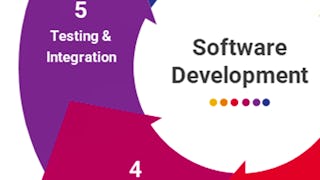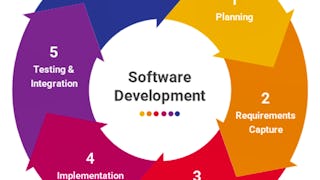Software Development Life Cycle (SDLC) is the process of developing software through planning, requirement analysis, design, implementation, testing, and maintenance. This course focuses on the requirement analysis phase of SDLC, and you will learn how to use UML models to capture the system requirements and to facilitate communication between client/users and developers. UML is a general purpose visual modeling language for systems. It can be used to highlight different aspects of the system that are of interest to different stakeholders. Data requirements are captured in the domain model, which describes the important concepts of the application domain as classes, associations between them and constraints on them. Functional requirements are captured in the use-case model to describe the interactions between the system and its environment (users, other systems).



Software Engineering: Modeling Software Systems using UML
This course is part of Software Engineering Specialization

Instructor: Kenneth W T Leung
27,538 already enrolled
Included with 
(307 reviews)
Recommended experience
Skills you'll gain
Details to know

Add to your LinkedIn profile
7 assignments
See how employees at top companies are mastering in-demand skills

Build your subject-matter expertise
- Learn new concepts from industry experts
- Gain a foundational understanding of a subject or tool
- Develop job-relevant skills with hands-on projects
- Earn a shareable career certificate

There are 7 modules in this course
Welcome to the first module of this course! In this module, you will learn: (1) Developing large software systems is a complex process.(2) How to deal with the complexity of software development.(3) What is software engineering.
What's included
3 videos1 reading1 assignment
In this module, you will learn: (1) What is UML. (2) How to model a software system as a collection of collaborating objects. (3) The basic modeling components (Class, Association and Aggregation/Composition) of UML class diagrams.
What's included
3 videos3 readings1 assignment
In this module, you will learn: (1) The basic modeling components (Association Class, Inheritance and Other Constraints) of UML Class Diagram.
What's included
3 videos5 readings1 assignment
In this module, you will learn: (1) What is requirements capture and its role in the software development process. (2) How to capture data requirements in a domain model. (3) How to evaluate attributes, classes, and associations in a domain model.
What's included
3 videos3 readings1 assignment
In this module, you will learn: (1) How to capture functional requirements in a use case model. (2) How to evaluate use cases in a use case model.
What's included
3 videos3 readings1 assignment
In this module, you will learn: (1) How to write use case specification to describe the behavior within a use case.
What's included
3 videos4 readings1 assignment
In this module, you will learn: (1) How to capture non-functional requirements. (2) How to validate system requirements.
What's included
2 videos5 readings1 assignment
Earn a career certificate
Add this credential to your LinkedIn profile, resume, or CV. Share it on social media and in your performance review.
Instructor

Explore more from Software Development


The Hong Kong University of Science and Technology


The Hong Kong University of Science and Technology


The Hong Kong University of Science and Technology
Why people choose Coursera for their career




Learner reviews
307 reviews
- 5 stars
70.03%
- 4 stars
21.49%
- 3 stars
4.23%
- 2 stars
1.62%
- 1 star
2.60%
Showing 3 of 307
Reviewed on Feb 20, 2023
Good course but if I didn't already know this stuff it would have taken 2 weeks.
Reviewed on Jul 22, 2024
This course was quite good actually, i learned many new things.
Reviewed on Oct 27, 2024
I like it but sometimes the subtitles are wrong due to difficult pronunciation of some words by the teacher.
New to Software Development? Start here.

Open new doors with Coursera Plus
Unlimited access to 10,000+ world-class courses, hands-on projects, and job-ready certificate programs - all included in your subscription
Advance your career with an online degree
Earn a degree from world-class universities - 100% online
Join over 3,400 global companies that choose Coursera for Business
Upskill your employees to excel in the digital economy
Frequently asked questions
Access to lectures and assignments depends on your type of enrollment. If you take a course in audit mode, you will be able to see most course materials for free. To access graded assignments and to earn a Certificate, you will need to purchase the Certificate experience, during or after your audit. If you don't see the audit option:
The course may not offer an audit option. You can try a Free Trial instead, or apply for Financial Aid.
The course may offer 'Full Course, No Certificate' instead. This option lets you see all course materials, submit required assessments, and get a final grade. This also means that you will not be able to purchase a Certificate experience.
When you enroll in the course, you get access to all of the courses in the Specialization, and you earn a certificate when you complete the work. Your electronic Certificate will be added to your Accomplishments page - from there, you can print your Certificate or add it to your LinkedIn profile. If you only want to read and view the course content, you can audit the course for free.
If you subscribed, you get a 7-day free trial during which you can cancel at no penalty. After that, we don’t give refunds, but you can cancel your subscription at any time. See our full refund policy.
More questions
Financial aid available,



